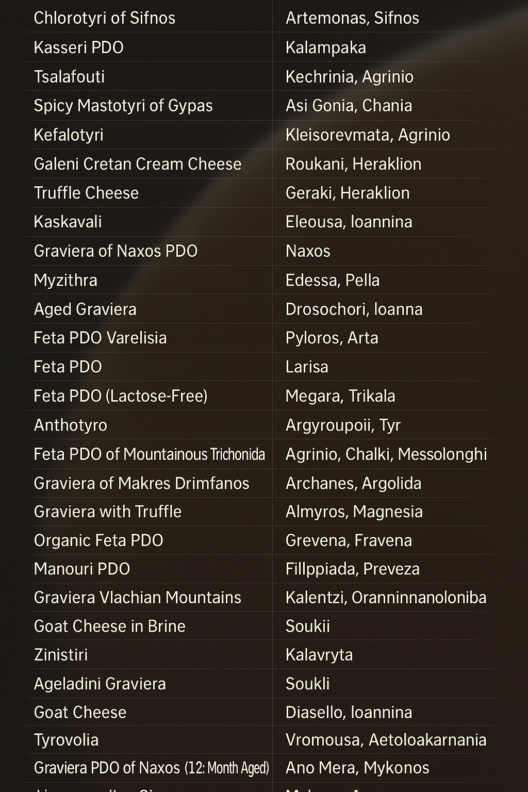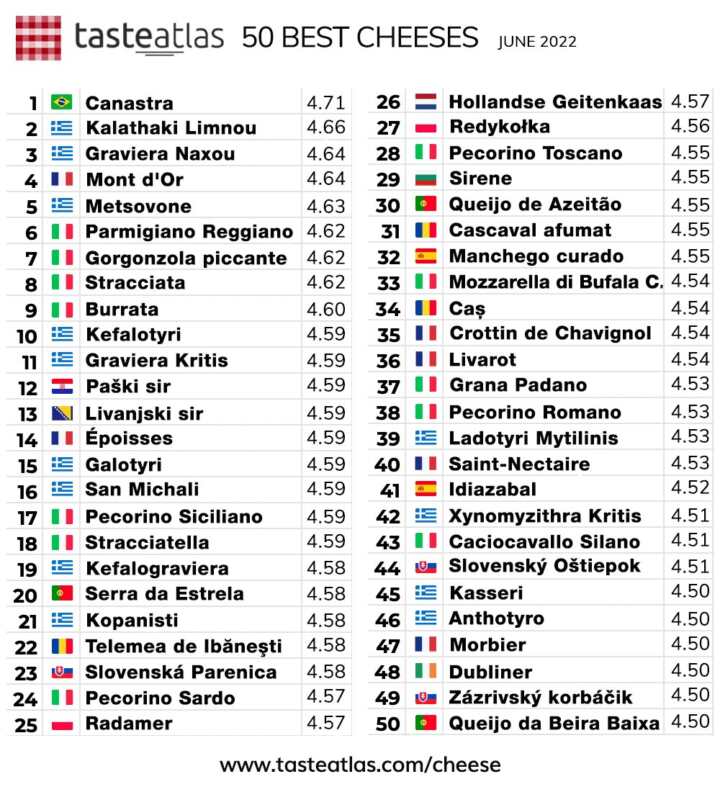
In Greece, the production of cheeses has a tradition of many centuries. In fact for ancient Greeks cheese was a sacred food.
Almost every region of Greece has its own traditional way of producing cheese. In total, more than 60 different species have been recorded.

There are several types of cheese, which are categorized based on their texture, color, or method of preparation. Some are white or yellow, fresh or ripe, but also soft, semi-hard and hard.
Taking a vote between 1350 world cheeses, the readers and members of TasteAtlas website ranked the best, in their opinion, cheeses in the world, some of them being quite unknown to the wider public, yet famous in their own country and among taste connoisseurs. In the top 50 list, we find 13 Greek cheeses -Greece is the only country with as many products on the list,

Let’s see the most famous, and favorite of our cheeses and their characteristics.
Yet another traditional hard Greek cheese. Made with both cow and sheep’s milk, I’ve found it to be one of the most popular Greek cheeses found within the county and in foods. It had a sharp taste that carries a hint of salt with it as well. I would say is resembles Parmesan (as I use it on top of pasta). It gets its sharp taste from being aged for 3 months. This is a very popular cheese for making saganaki.
Feta is the most famous Greek cheese, affectionately called ‘the princess of cheeses’. The cheese is made from sheep’s milk or a mixture of sheep’s and goat’s milk (the latter should not exceed 30%). It is produced in the regions of Macedonia, Thessaly, Thrace, Epirus, the Peloponnese, and Central Greece.
Feta is traditionally produced with non-pasteurized milk, although nowadays the use of pasteurized milk is also allowed. The cheese is made in large square or triangle-shaped molds and preserved in wooden barrels or tin containers filled with brine in order to keep it fresh and to preserve its acidity.
Not a well known cheese outside of Greece. However, it’s important to note that it is one of only a few others Greek chesses that is smoked (the other, Metsovone, is below). Mostly made entirely of cow’s milk.
What makes this hard salty cheese unique is that during its 12-month aging process, it is kept in olive oil. Made from sheep and goat milk, it is shaped in to “small heads” (kefalaki) and eaten. Goes well with olives and bread.
If you are in Athens, this Greek cheese in like cream cheese. Like the others, this cheese is made from either sheep or goat milk. Great for sweet phyllo pies.
The second smoked cheese on this list. Mostly made from cow’s milk and ages for about 3 months. At the time of writing this, I have yet to try this Greek cheese.
Another cheese I had in Crete (in a cheese pie), it is made from either the milk from goat, sheep, or a cow (can include all three however). It has a rich history and is looked at as the first whey (from sheep or goat) cheese.
Traditional greek cheese Kasseri with semi-hard texture, with minimal holes or without, is so popular that often we call almost every yellow cheese we see by its name. It has a rich taste, slightly salty and has a characteristic aroma of goat’s and sheep’s milk as it is produced from their milk, exclusively in various regions of Macedonia and Thessaly, but also in the Prefectures of Lesvos and Xanthi. It is recommended to be kept at room temperature for 20-30 minutes before consuming. In that way the unique aromas are better released from the sheep’s milk. Kasseri matures for at least 3 months but in fact the more it matures the better it becomes. It is pleasantly eaten plain with hot bread and it is used for pies.
The famous traditional white cheese of Cyprus, Halloumi has been made for hundreds of years in Cyprus. The recipe was usually passed from mother to daughter because the men guarded the sheep. The women at the house made the cheese from a mixture of sheep and goat milk but also even cow’s milk. It is a semi-hard cheese, rubbery and squeaky with rectangular or semicircular shape and is usually folded. Halloumi has a high melting point meaning it can be grilled, boiled or fried without melting. It can be eaten raw and fresh with fruit and white wines.
Produced in Thessaly and Epirus, galotiri is made from feta, milk and yoghurt. Because it doesn’t travel well, it is hardly known outside of Greece, but this cheese is milky and soft and can be used for dipping, or spread on a slice of bread or a cracker. Low in fat and calories, galotiri is a great alternative to cottage cheese – perfect for late-night, open-air movie screenings when you’re craving a light snack.
It is a white cheese similar to feta and it is usually consumed as a table cheese served with fruits, but also in Greek salad. It is salty and has a mild and pleasant flavour. According to the traditional method, the curd is put in a kalathaki (“small basket”) for draining and organic acidification.
This hard cheese is obtained exclusively from the milk of cows bred on the island of Syros and has a buttery taste. It can be served as an appetizer, and it is also used as an ingredient in soufflés or omelettes.
The flavour of this cheese is often described as spicy and peppery and is produced on Tinos and Mykonos islands. The cheese is mainly served as an appetizer with ouzo, retsina, or tsikoudia, and is often used in sandwiches as is has a soft spreadable texture.
It is a white soft cheese with a sweet and sour taste that can be found on Crete. Its texture can vary from creamy to granular.
It is a hard cheese made from sheep’s and goat’s milk, a tasty cross between Kefalotyri, a salty, intensely flavoured cheese, and the mellow Graviera cheese. It is a new type of cheese, created in the ‘60s.






Leave a Reply